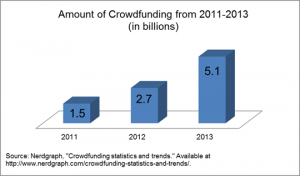Fund the Farms! Crowdfunding’s Quiet Success
The United States has seen a rise in small businesses since the beginnings of the internet. Fears of mom and pop stores going out of business to global dominators such as Walmart has curbed significantly in years past. Now, any person with a website and credit card account can receive payments and create virtual marketplaces. Recently crowd funding has become a new form of micro finance in that individuals are able to invest into companies and people that they believe in. The world is taking the power from big banks and investment firms to instead invest amongst one another.
Websites such as Kickstarter and Indiegogo are two of the more popular websites as they provide compensation varying from notes as a thank you to even flying the investor out for a company dinner. These new types of finance are gaining steam as $5.1 billion dollars was crowd funded in 2013, proving continued growth in the industry. This past week a new type of crowd funding offered its first available project, Agfunder.
Agfunder is a new type of crowd sourcing in that users are able to invest into large scale agricultural projects instead of small companies. This could prove revolutionary for the food industry as the population will only continue to rise and food production continues to not meet world demands. The ability to invest in Industrial farms is huge, as it removes a lot of the pressure off of banks and local investors. As new technologies emerge it’s hard for farms to accumulate excess capital to reinvent their farms. An agricultural geared website is a fantastic idea, that has huge upside potential to feeding the world, but it is far from perfect.
However, there are significant drawbacks with Agfunder that other crowd funding websites do not have. Agfunder misses many opportunities by only allowing SEC certified investors to invest into the farming businesses. They also only accept a staggering 5% of farms who apply to be on their website. The magic of websites such as Kickstarter is the ability to allow any company with an idea to bring that idea to market. They then allow the people to decide what gets funded and what does not. By allowing microloans to be in the hand of the people, it can be highly market geared and weed out naturally the winners and losers. For those interested in assisting small scale farming, and helping developing countries I bring attention to the small website Kiva.
Kiva excels where Agfunder does not. Kiva takes small microloans and gives them to small businesses all over the world from shoe makers in Kenya to a cattle farmer in Nicaragua. For just $25 the loan will be disbursed, interest is accumulated and the money is sent back to the person giving the loan to either reinvest or withdraw to PayPal. Everyone sees the late night adds for sponsoring children in developing nations, but this way actually earns money and has the potential for reinvestment. There are too many instances of dead aid, and this way would allow money to continually move through areas in need. Developing countries are not the only areas of need as to date nearly $8.5 million dollars has been invested into the US through Kiva. In a country where many move here for the American dream of creating and building business, Kiva and other crowd funding websites are attempting to propel that dream.

I think sites like Kickstarter are great, and I’d sure rather see agriculture funding – or any other – come from private sources rather than in the form of government subsidies!
Health projects prove harder to crowdfund as the largest, most popular sites like Kickstarter reject health projects. Idea.me recently started up in the United States after much success in Latin America.
As Latin Americans have struggled with Obamacare we’re trying idea.me to crowdfund a new idea:
http://bit.ly/crowdfunding4healthcare
What sort of health projects could go through idea.me? I have seen crowd funding things for body modifications, but not for health care in general. What is Nav? What does it do?
David,
Sorry, misplaced the response. Thank you for asking about NAV.
As actuaries, we’ve been doing a lot of work around actuarial value, minimum value, and helping navigate Obamacare. Our plan is to help individuals (and ultimately business owners) navigate their decisions; understanding how the plan they choose may fare under the law.
N
David,
Thank you for asking.
As actuaries, we’ve been doing a lot of work around actuarial value, minimum value, and helping navigate Obamacare. Our plan is to help individuals (and ultimately business owners) navigate their decisions; understanding how the plan they choose may fare under the law.
N